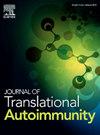Dysregulation of innate and adaptive lymphoid immunity may have implications for symptom attribution and predict responses to targeted therapies in neuropsychiatric systemic lupus erythematosus
IF 3.6
Q2 IMMUNOLOGY
引用次数: 0
Abstract
Objectives
To gain insights into the pathogenesis of neuropsychiatric systemic lupus erythematosus (NPSLE) and identify potential drug targets through investigation of whole-blood human transcriptome.
Methods
We analysed differentially expressed genes in peripheral blood from active central nervous system (CNS) lupus (n = 26) and active non-neuropsychiatric SLE (n = 38) patients versus healthy controls (n = 497) from the European PRECISESADS project (NTC02890121). We further explored dysregulated gene modules in active CNS lupus and their correlation with serological markers. Lastly, we performed regulatory network and druggability analysis.
Results
Unsupervised weighted gene co-expression network analysis (WGCNA) revealed 23 dysregulated gene modules and two subgroups of active CNS lupus. The interferon gene module was prominently upregulated in subgroup 1, while the B cell, T cell, and cytotoxic/natural killer (NK) cell modules were downregulated. Subgroup 2 showed less marked dysregulation patterns. Subgroup 1 had lower estimated proportions of lymphoid cell subsets and proportionally more patients positive for anti-dsDNA antibodies compared to subgroup 2, pointing to molecularly distinct subgroups or misclassification of subgroup 2. In silico prediction algorithms demonstrated a greater anticipated response to anifrolumab, C3 inhibitors, and calcineurin inhibitors for patients in CNS lupus subgroup 1 compared with subgroup 2.
Conclusions
Gene dysregulation patterns related to innate and adaptive lymphoid immunity separated active CNS lupus patients into two distinct subgroups with differential anticipated response to type I interferon, C3, and calcineurin inhibition. Our study provides a conceptual framework for precision medicine in NPSLE and implications for overcoming the major clinical challenge of attributing neuropsychiatric features to SLE versus other causes.
先天性和适应性淋巴细胞免疫失调可能与神经精神系统性红斑狼疮的症状归因有关,并预测对靶向治疗的反应
目的通过对人全血转录组的研究,了解神经精神系统性红斑狼疮(NPSLE)的发病机制,并寻找潜在的药物靶点。方法我们分析了来自欧洲PRECISESADS项目(NTC02890121)的活动性中枢神经系统(CNS)狼疮(n = 26)和活动性非神经精神性SLE (n = 38)患者与健康对照组(n = 497)外周血中差异表达的基因。我们进一步探讨了活动性中枢神经系统狼疮中失调的基因模块及其与血清学标志物的相关性。最后,我们进行了监管网络和药物分析。结果监督加权基因共表达网络分析(WGCNA)揭示了23个基因模块和两个中枢神经系统狼疮亚群。干扰素基因模块在亚组1中显著上调,而B细胞、T细胞和细胞毒性/自然杀伤(NK)细胞模块下调。亚组2表现出较不明显的失调模式。与亚组2相比,亚组1淋巴样细胞亚群的估计比例更低,抗dsdna抗体阳性的患者比例更多,这表明亚组2分子不同或分类错误。计算机预测算法显示,与2亚组相比,CNS狼疮1亚组患者对anfrolumab、C3抑制剂和钙调磷酸酶抑制剂的预期反应更大。结论先天性和适应性淋巴细胞免疫相关的基因失调模式将活动性中枢神经系统狼疮患者分为两个不同的亚组,对I型干扰素、C3和钙调磷酸酶抑制的预期反应不同。我们的研究为NPSLE的精准医学提供了一个概念框架,并为克服将神经精神特征归因于SLE与其他原因的主要临床挑战提供了启示。
本文章由计算机程序翻译,如有差异,请以英文原文为准。
求助全文
约1分钟内获得全文
求助全文
来源期刊

Journal of Translational Autoimmunity
Medicine-Immunology and Allergy
CiteScore
7.80
自引率
2.60%
发文量
33
审稿时长
55 days
 求助内容:
求助内容: 应助结果提醒方式:
应助结果提醒方式:


